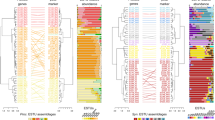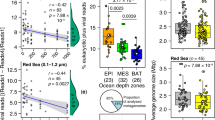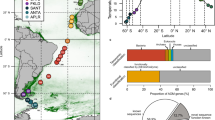Abstract
The core properties of microbial genomes, including GC content and genome size, are known to vary widely among different bacteria and archaea1,2. Several hypotheses have been proposed to explain this genomic variability, but the fundamental drivers that shape bacterial and archaeal genomic properties remain uncertain3,4,5,6,7. Here, we report the existence of a sharp genomic transition zone below the photic zone, where bacterial and archaeal genomes and proteomes undergo a community-wide punctuated shift. Across a narrow range of increasing depth of just tens of metres, diverse microbial clades trend towards larger genome size, higher genomic GC content, and proteins with higher nitrogen but lower carbon content. These community-wide changes in genome features appear to be driven by gradients in the surrounding environmental energy and nutrient fields. Collectively, our data support hypotheses invoking nutrient limitation as a central driver in the evolution of core bacterial and archaeal genomic and proteomic properties.
This is a preview of subscription content, access via your institution
Access options
Access Nature and 54 other Nature Portfolio journals
Get Nature+, our best-value online-access subscription
$29.99 / 30 days
cancel any time
Subscribe to this journal
Receive 12 digital issues and online access to articles
$119.00 per year
only $9.92 per issue
Buy this article
- Purchase on Springer Link
- Instant access to full article PDF
Prices may be subject to local taxes which are calculated during checkout



Similar content being viewed by others
References
Ochman, H. & Davalos, L. M. The nature and dynamics of bacterial genomes. Science 311, 1730–1733 (2006).
McCutcheon, J. P. & Moran, N. A. Extreme genome reduction in symbiotic bacteria. Nat. Rev. Microbiol. 10, 13–26 (2011).
Batut, B., Knibbe, C., Marais, G. & Daubin, V. Reductive genome evolution at both ends of the bacterial population size spectrum. Nat. Rev. Microbiol. 12, 841–850 (2014).
Lynch, M. & Conery, J. S. The origins of genome complexity. Science 302, 1401–1404 (2003).
Daubin, V. & Moran, N. A. Comment on ‘The origins of genome complexity’. Science 306, 978 (2004).
Giovannoni, S. J. Genome streamlining in a cosmopolitan oceanic bacterium. Science 309, 1242–1245 (2005).
Viklund, J., Ettema, T. J. G. & Andersson, S. G. E. Independent genome reduction and phylogenetic reclassification of the oceanic SAR11 clade. Mol. Biol. Evol. 29, 599–615 (2012).
DeLong, E. F. et al. Community genomics among stratified microbial assemblages in the ocean’s interior. Science 311, 496–503 (2006).
Konstantinidis, K. T., Braff, J., Karl, D. M. & DeLong, E. F. Comparative metagenomic analysis of a microbial community residing at a depth of 4,000 meters at station ALOHA in the North Pacific subtropical gyre. Appl. Environ. Microbiol. 75, 5345–5355 (2009).
Mizuno, C. M., Ghai, R., Saghaï, A., López-García, P. & Rodriguez-Valera, F. Genomes of abundant and widespread viruses from the deep ocean. mBio 7, e00805–16 (2016).
Swan, B. K. et al. Potential for chemolithoautotrophy among ubiquitous bacteria lineages in the dark ocean. Science 333, 1296–1300 (2011).
Karl, D. M. & Lukas, R. The Hawaii Ocean Time-series (HOT) program: background, rationale and field implementation. Deep Sea Res. Part II 43, 129–156 (1996).
Bryant, J. A. et al. Wind and sunlight shape microbial diversity in surface waters of the North Pacific Subtropical Gyre. ISME J. 10, 1308–1322 (2016).
Laws, E. A., Letelier, R. M. & Karl, D. M. Estimating the compensation irradiance in the ocean: the importance of accounting for non-photosynthetic uptake of inorganic carbon. Deep Sea Res. Part I 93, 35–40 (2014).
Sunagawa, S. et al. Metagenomic species profiling using universal phylogenetic marker genes. Nat. Methods 10, 1196–1199 (2013).
Mende, D. R., Sunagawa, S., Zeller, G. & Bork, P. Accurate and universal delineation of prokaryotic species. Nat. Methods 10, 881–884 (2013).
Letelier, R. M., Karl, D. M., Abbott, M. R. & Bidigare, R. R. Light driven seasonal patterns of chlorophyll and nitrate in the lower euphotic zone of the North Pacific Subtropical Gyre. Limnol. Oceanogr. 49, 508–519 (2004).
Swan, B. K. et al. Prevalent genome streamlining and latitudinal divergence of planktonic bacteria in the surface ocean. Proc. Natl Acad. Sci. USA 110, 11463–11468 (2013).
Giovannoni, S. J., Cameron Thrash, J. & Temperton, B. Implications of streamlining theory for microbial ecology. ISME J. 8, 1553–1565 (2014).
Biller, S. J., Berube, P. M., Lindell, D. & Chisholm, S. W. Prochlorococcus: the structure and function of collective diversity. Nat. Rev. Microbiol. 13, 13–27 (2015).
Dupont, C. L. et al. Genomic insights to SAR86, an abundant and uncultivated marine bacterial lineage. ISME J. 6, 1186–1199 (2012).
Bragg, J. G. & Hyder, C. L. Nitrogen versus carbon use in prokaryotic genomes and proteomes. Proc. Biol. Sci. 271(Suppl. 5), S374–S377 (2004).
Baudouin-Cornu, P., Schuerer, K., Marlière, P. & Thomas, D. Intimate evolution of proteins. Proteome atomic content correlates with genome base composition. J. Biol. Chem. 279, 5421–5428 (2004).
Grzymski, J. J. & Dussaq, A. M. The significance of nitrogen cost minimization in proteomes of marine microorganisms. ISME J. 6, 71–80 (2012).
Sunagawa, S. et al. Ocean plankton. Structure and function of the global ocean microbiome. Science 348, 1261359 (2015).
Rocap, G. et al. Genome divergence in two Prochlorococcus ecotypes reflects oceanic niche differentiation. Nature 424, 1042–1047 (2003).
Moran, N. A., McCutcheon, J. P. & Nakabachi, A. Genomics and evolution of heritable bacterial symbionts. Annu. Rev. Genet. 42, 165–190 (2008).
Baudouin-Cornu, P., Surdin-Kerjan, Y., Marlière, P. & Thomas, D. Molecular evolution of protein atomic composition. Science 293, 297–300 (2001).
Partensky, F. & Garczarek, L. Prochlorococcus: advantages and limits of minimalism. Ann. Rev. Mar. Sci. 2, 305–331 (2010).
Morris, J. J., Lenski, R. E. & Zinser, E. R. The black queen hypothesis: evolution of dependencies through adaptive gene loss. mBio 3, e00036–12 (2012).
Chevreux, B., Wetter, T. & Suhai, S. Genome sequence assembly using trace signals and additional sequence information. GCB 99, 45–46 (1999).
Hyatt, D. et al. Prodigal: prokaryotic gene recognition and translation initiation site identification. BMC Bioinformatics 11, 119 (2010).
Fu, L., Niu, B., Zhu, Z., Wu, S. & Li, W. CD-HIT: accelerated for clustering the next-generation sequencing data. Bioinformatics 28, 3150–3152 (2012).
Li, W. & Godzik, A. CD-HIT: a fast program for clustering and comparing large sets of protein or nucleotide sequences. Bioinformatics 22, 1658–1659 (2006).
Tatusova, T., Ciufo, S., Fedorov, B., O’Neill, K. & Tolstoy, I. RefSeq microbial genomes database: new representation and annotation strategy. Nucleic Acids Res. 42, D553–D559 (2014).
Kanehisa, M., Furumichi, M., Tanabe, M., Sato, Y. & Morishima, K. KEGG: new perspectives on genomes, pathways, diseases and drugs. Nucleic Acids Res. 45, D353–D361 (2016).
Huerta-Cepas, J. et al. eggNOG 4.5: a hierarchical orthology framework with improved functional annotations for eukaryotic, prokaryotic and viral sequences. Nucleic Acids Res. 44, D286–D293 (2016).
Kiełbasa, S. M., Wan, R., Sato, K., Horton, P. & Frith, M. C. Adaptive seeds tame genomic sequence comparison. Genome Res. 21, 487–493 (2011).
Huerta-Cepas, J. et al. Fast genome-wide functional annotation through orthology assignment by eggNOG-mapper. Mol. Biol. Evol. 34, 2115–2122 (2017).
Ciccarelli, F. D. et al. Toward automatic reconstruction of a highly resolved tree of life. Science 311, 1283–1287 (2006).
Huerta-Cepas, J., Serra, F. & Bork, P. ETE 3: reconstruction, analysis, and visualization of phylogenomic data. Mol. Biol. Evol. 33, 1635–1638 (2016).
Price, M. N., Dehal, P. S. & Arkin, A. P. FastTree 2—approximately maximum-likelihood trees for large alignments. PLoS ONE 5, e9490 (2010).
Rognes, T., Flouri, T., Nichols, B., Quince, C. & Mahé, F. VSEARCH: a versatile open source tool for metagenomics. PeerJ 4, e2584 (2016).
Galperin, M. Y. & Koonin, E. V. Who’s your neighbor? New computational approaches for functional genomics. Nat. Biotechnol. 18, 609–613 (2000).
Dixon, P. VEGAN, a package of R functions for community ecology. J. Veg. Sci. 14, 927 (2003).
Logares, R. et al. Metagenomic 16S rDNA Illumina tags are a powerful alternative to amplicon sequencing to explore diversity and structure of microbial communities. Environ. Microbiol. 16, 2659–2671 (2014).
Edgar, R. C. Search and clustering orders of magnitude faster than BLAST. Bioinformatics 26, 2460–2461 (2010).
Quast, C. et al. The SILVA ribosomal RNA gene database project: improved data processing and web-based tools. Nucleic Acids Res. 41, D590–D596 (2013).
Yilmaz, P. et al. The SILVA and "All-species Living Tree Project (LTP)" taxonomic frameworks. Nucleic Acids Res. 42, D643–D648 (2013).
Ramazzotti, M., Berná, L., Donati, C. & Cavalieri, D. riboFrame: an improved method for microbial taxonomy profiling from non-targeted metagenomics. Front. Genet. 6, 329 (2015).
Langmead, B. & Salzberg, S. L. Fast gapped-read alignment with Bowtie 2. Nat. Methods 9, 357–359 (2012).
Li, H. & Durbin, R. Fast and accurate short read alignment with Burrows–Wheeler transform. Bioinformatics 25, 1754–1760 (2009).
Arumugam, M., Harrington, E. D., Foerstner, K. U., Raes, J. & Bork, P. SmashCommunity: a metagenomic annotation and analysis tool. Bioinformatics 26, 2977–2978 (2010).
Aylward, F. O. et al. Microbial community transcriptional networks are conserved in three domains at ocean basin scales. Proc. Natl Acad. Sci. USA 112, 5443–5448 (2015).
Langfelder, P. & Horvath, S. WGCNA: an R package for weighted correlation network analysis. BMC Bioinformatics 9, 559 (2008).
Love, M. I., Huber, W. & Anders, S. Moderated estimation of fold change and dispersion for RNA-seq data with DESeq2. Genome Biol. 15, 550 (2014).
Zhang, B. & Horvath, S. A general framework for weighted gene co-expression network analysis. Stat. Appl. Genet. Mol. Biol. 4, 17 (2005).
Cock, P. J. A. et al. Biopython: freely available Python tools for computational molecular biology and bioinformatics. Bioinformatics 25, 1422–1423 (2009).
Wright, F. The ‘effective number of codons’ used in a gene. Gene 87, 23–29 (1990).
Acknowledgements
The authors thank the captain and crew of the R/V Kilo Moana, and the Hawaii Ocean Time-series marine operations team, for their expert assistance with sample collection and oceanographic data acquisition and analyses at sea. The authors also thank T. Palden, A. Romano and P. Den Uyl for their able assistance in DNA library preparation and DNA sequencing, and B. Barone and L. Fujieki for expert advice and assistance in accessing and displaying HOT oceanographic data sets. The authors also thank S. Sunagawa and G. Zeller for advice and assistance with mOTU analyses. This research was supported by the Simons Foundation (SCOPE award ID 329108 to E.F.D. and D.M.K.), the Gordon and Betty Moore Foundation (through grants GBMF 3777 to E.F.D. and GBMF3794 to D.M.K.) and the National Science Foundation for support of the HOT programme (including the most recent OCE1260164), as well as support to D.R.M. from EMBO (ALTF 721-2015) and the European Commission (LTFCOFUND2013, GA-2013-609409) and support to J.A.B. through the US EPA Science to Achieve Results Fellowship. This work is a contribution of the Simons Collaboration on Ocean Processes and Ecology, and the Center for Microbial Oceanography: Research and Education.
Author information
Authors and Affiliations
Contributions
E.F.D. and D.M.K. designed the overall study, sample and data collection, and analyses. T.N., J.M.E., D.R.M., J.A.B. and F.O.A. performed bioinformatics analyses with input from E.F.D. The manuscript was written by E.F.D., D.R.M., J.A.B. and F.O.A.
Corresponding author
Ethics declarations
Competing interests
The authors declare no competing financial interests.
Additional information
Publisher’s note: Springer Nature remains neutral with regard to jurisdictional claims in published maps and institutional affiliations.
Electronic supplementary material
Supplementary Information
Supplementary Figures 1–10.
Supplementary Table 1
Sequencing and assembly statistics.
Supplementary Table 2
Physicochemical and biological environmental data.
Supplementary Table 3
Chlorophyll measurements.
Supplementary Table 4
SRA database accession information.
Rights and permissions
About this article
Cite this article
Mende, D.R., Bryant, J.A., Aylward, F.O. et al. Environmental drivers of a microbial genomic transition zone in the ocean’s interior. Nat Microbiol 2, 1367–1373 (2017). https://doi.org/10.1038/s41564-017-0008-3
Received:
Accepted:
Published:
Issue Date:
DOI: https://doi.org/10.1038/s41564-017-0008-3
This article is cited by
-
Metagenome-assembled genomes reveal greatly expanded taxonomic and functional diversification of the abundant marine Roseobacter RCA cluster
Microbiome (2023)
-
Ecophysiology and genomics of the brackish water adapted SAR11 subclade IIIa
The ISME Journal (2023)
-
Abiotic selection of microbial genome size in the global ocean
Nature Communications (2023)
-
Bacterial genome size and gene functional diversity negatively correlate with taxonomic diversity along a pH gradient
Nature Communications (2023)
-
A systematic analysis of marine lysogens and proviruses
Nature Communications (2023)



